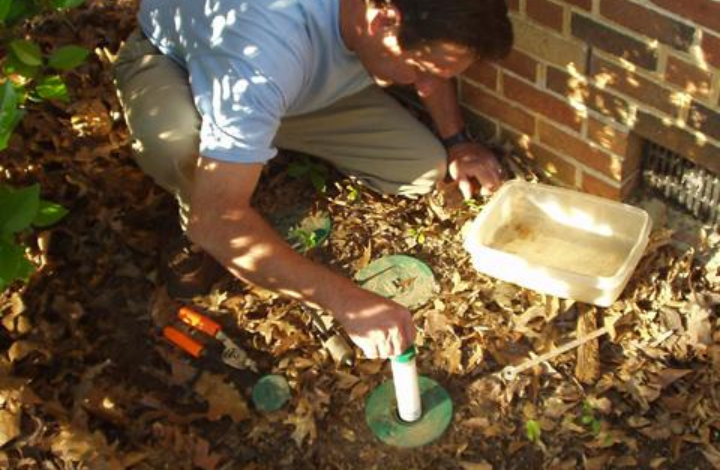Are Termite Bait Stations Safe and How Do They Operate?

Although termite baiting systems can prevent infestations through early detection, termite inspections and treatments are frequently the most efficient approach to locate and eradicate existing termite infestations within a property.
In reality, termite baiting stations are made to function in this manner.
Internal infestations can be stopped and detected early for extended periods of time. Due of their greater preventive nature, termite traps and baiting stations are a popular choice among many homeowners.
How termite baiting devices function
The purpose of termite baits is to both attract and eliminate termites, just as you might anticipate. However, termite baiting stations are intelligently constructed to cooperate with the natural behaviour of termites, unlike other, more conventional kinds of pest management and eradication approaches.
More significantly, they are made to destroy the whole termite colony in addition to the termites that are already present inside the traps.
This is why termite baiting stations are so successful. They are not just a long-term, cost-effective solution, but also remarkably successful in eliminating sizable termite colonies.

Baiting for termites versus chemical/barrier treatments
The majority of property owners are aware that there are several options for treating termites. Options include physical obstacles, chemical treatments and barriers, and of course, baiting systems.
Aside from price, the type of property is often what dictates which form of treatment is most suited. For instance, termite baits are more frequently employed on split-level or pole-built homes since they aren’t actually physically attached to a building or structure. Because the property is elevated above the earth, where conventional barriers would be useless, this is the case.
How do termite baiting stations appear?
The actual termite bait are around 30 cm long and resemble vented cylindrical tubing. Each trap is equipped with a locking cover that has tiny ventilation grills on top for safety. Termite bait station is flush with the earth at the very top and sunk deep into the ground.
The following justifies why traps are set up in this manner.
- First and foremost, so that they don’t create any impediments in the garden or property
- Termites move underground, exactly like ants in search of food, and most crucial, so that they’re not an eyesore.
How termite baiting is carried out
The fact that termite baiting systems are basically a simple 3-step termite-killing process is what makes them so incredibly successful.
The steps are as follows:
The baiting stations attract termites.
It goes without saying that the initial step in the procedure is to lure any local termites to the baiting stations. This is accomplished by putting Tasmanian Oak wood, which termites find to be an appealing food source, into the traps. Termites consume and digest the cellulose found in wood with the aid of protozoa and microorganisms found in their digestive tracts. However, some types of cellulose material are more alluring than others, with Tasmanian Oak being preferred by termites.

Our pest treatment specialists also include a termite attractant called Focus, which has a range of up to 3 metres, in addition to the wood. A month’s worth of concentrate is added, giving the trap ample time to attract a significant number of termites. Using this technique, we can identify any early indications of termite activity around your home and set up the subsequent phase in the procedure.
Addition of hexaflumuron to the baiting stations
After a significant number of termites have been drawn to the traps, they are subsequently filled with Hexaflumuron, an insect growth regulator that kills the exoskeleton of the termites. When hexaflumuron is combined with water, it acquires a pasty texture (hexaflumuron is a powder when it is unprocessed).
Termites are drawn to the cellulose that is included in hexaflumuron because they perceive it to be a reliable food supply.
When hexaflumuron is ingested, it –
It damages and softens the termite’s exo skeleton, often known as its “outer shell,” and makes the termites’ mandibles softer, making them incapable of chewing wood. The primary colony is impacted and finally goes extinct.
There are two ways that the primary colony or nest might get infected.
- Termites that consume the poison return to the main colony, where more termites consume their excrement to produce the same effect.
- In an effort to feed the young termites, termites bring the poison back to the nest, where it has the same effect as before.
When the termites are unable to shed their exoskeletons to create room for fresh development, the colony suffers its fatal blow. Naturally, since they are unable to breed, this implies that not only the current termites are eliminated but also any future generations as well.
As you can see, this is a very efficient technique that, once implemented, performs admirably.
Services and inspections for termite bait
Customers often sign a 12-month contract while using baiting stations. This offers the following to the client:
- Monthly inspections
- Installation of the baits/traps
- Ongoing servicing and maintenance
Customers are called or sent an SMS message every month to remind them that their inspections are due. Each trap must be examined once a month in order to look for any possible activity.

A single pest control specialist can often install a typical termite bait system for a typical three-bedroom home on a typical-sized block in a day. Typically, the traps are positioned carefully around the perimeter of the property, every three metres. There are no unsightly boxes or other impediments in the yard since the traps are nearly undetectable because they sit flush with the ground.
We examine the baits during inspection and complete a service form so that we are fully aware of the condition of every trap on the premises. Traps are typically inspected every eight weeks during the second and third years. As termite colonies are continually migrating through the earth, ongoing attention is required. As a result, it’s typical for a residence equipped with a termite bait system to experience three to four distinct strikes each year from various termite colonies.
Termite bait systems are a wise investment for people looking for a long-term, more permanent solution because they may last up to 10 years.
Termite baiting systems, in other words, serve as a long-term “alarm system” for termites. We may act quickly and immediately if termites are actively eating in the traps since it’s probable they’ve built a nest close by.
Alternatively, clients may feel secure knowing that their home will be free from any possible infestations provided the baits continue to be clear.
Termite baits are entirely secure
When it comes to termite management, termite baiting systems are frequently the technique of choice for property owners who are worried about the health and security of their loved ones, children, and pets. Each station is secured with a secure cap and buried in the earth, as was already indicated.
As the baiting mixture is only intended to hurt insects with exo-skeletons, it is safe for use around people, pets, and wildlife. Compared to a general or all-encompassing insect pesticide or deterrent, this form of controlled elimination is much more efficient and secure.



